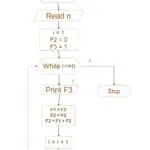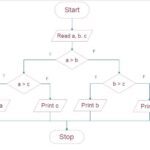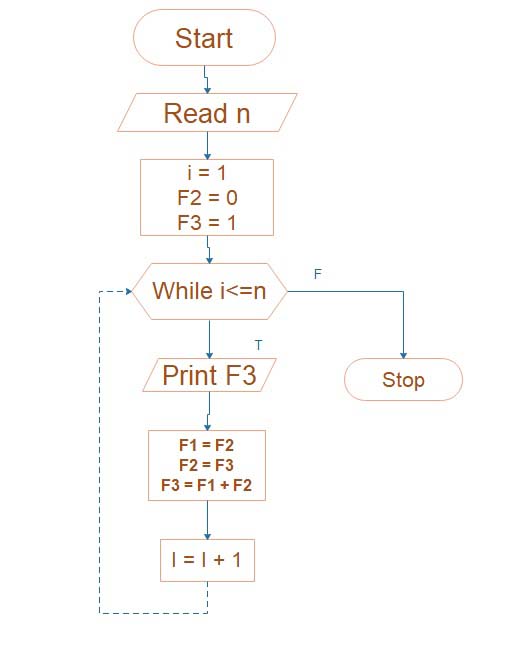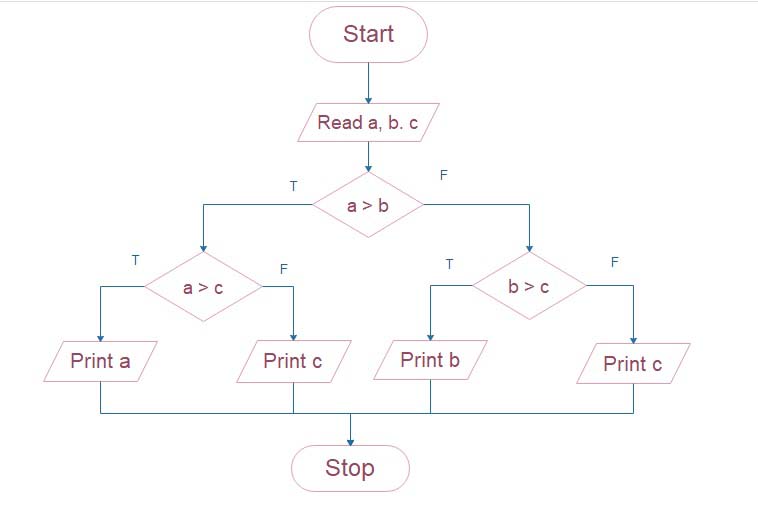Flowchart and Algorithm of Prime Number
Algorithm Prime Number
Draw the flowchart and write an algorithm to determine whether a number is prime or not.
Table of Contents
Algorithm: Prime Number Check
- Input: A positive integer
numbergreater than 1. - Output: True if
numberis a prime number, otherwise False. - This is the algorithm to determine whether a number is a prime number or not.
- n-Accepted number
- i-loop variable
step 1: start
step 2: [Accept a number] read n
step 3: set i = 2
step 4: Repeat steps 5and 6 until i < n
step 5: [ check whether n is divisible or not]
if n % i == 0 then
Goto step7
Else
Goto step6
step 6: set i = i + 1
step 7: if i == n then
Print "number is prime"
Else
Print "number is not prime"
step 8: stopExplanation:
Since prime numbers are defined as natural numbers bigger than 1, the procedure first determines if the input value is smaller than 2. The primality test is performed if the number is two or above.
The procedure then loops over every possible divisor between 2 and the input number’s square root. It determines if the input number may be divided by any of these factors. It returns False, indicating that the number is not a prime number if it discovers any divisor other than 1 and itself.
If the loop does not identify any divisors, the input number is a prime number since it can only be divided by one and itself. It returns True in this instance.
what is a prime number?
A prime number is a positive integer bigger than 1 with just itself and the number 1 as its other positive divisors. In other words, only 1 and the number itself may split a prime number into two halves. Prime number examples are 2, 3, 5, 7, 11, and so on. They are crucial to number theory and have important uses in a variety of disciplines, such as computer science and encryption.
Flowchart of Prime Number

The flowchart steps to determine whether a number is a prime number or not:
- Start
- Input the number to be checked for primality
- Set a variable divisor to 2
- Calculate the square root of the input number and store it in a variable sqrt_num
- If the input number is less than 2, go to step 11 (not prime)
- If the divisor is greater than sqrt_num, go to step 10 (prime)
- Check if the input number is divisible by the divisor
- If it is divisible (remainder = 0), go to step 11 (not prime)
- Increment the divisor by 1 and go to step 6
- Output “Number is prime”
- Output “Number is not prime”
- End
Since prime numbers are defined as natural numbers bigger than 1, the flowchart checks to see if the input value is smaller than 2. The primality test is conducted by the flowchart if the input number is two or higher. In addition, as described in the preceding replies, the flowchart employs a loop (steps 6-9) to search for divisors up to the input number’s square root.
Prime Number in c
How to determine whether a number is prime or not in the C programming language
#include <stdio.h>
#include <stdbool.h>
#include <math.h>
// Function to check if a number is prime
bool is_prime(int number) {
// Check if number is less than 2
if (number < 2) {
return false;
}
// Check for divisors up to square root of the number
for (int i = 2; i <= sqrt(number); i++) {
if (number % i == 0) {
return false;
}
}
return true;
}
int main() {
int num;
printf("Enter a number: ");
scanf("%d", &num);
// Call the is_prime function to check if the number is prime or not
if (is_prime(num)) {
printf("%d is a prime number.\n", num);
} else {
printf("%d is not a prime number.\n", num);
}
return 0;
}
Prime Number program in c
The prime number function in this C program determines whether an integer number is a prime number by returning a boolean result (yes or false) depending on the input.
The reasoning behind the is_prime function is the same as previously described:
If the number is fewer than two, it is verified. Because prime numbers can be bigger than 1, if it is, it instantly returns false.
Using a for loop and the sqrt function from the math.h library, it then repeatedly iterates from 2 up to the number’s square root to see whether it is divisible by any of these numbers. It returns false if it discovers any other divisor other than itself.
The loop returns true, indicating that the integer is prime, if no divisors are discovered.
Using scanf, the main function requests a user-supplied number, which is then passed as an argument to the is_prime function. We output the relevant message indicating whether the number is prime or not based on the function’s return value.
Prime Number in Python
Recognize the definition of a prime number: A prime number is a natural number higher than 1 that has just itself and the number 1 as its only other positive divisors. To put it another way, a prime number can only be divided by itself and by one.
Verify that it is less than 2: Since prime numbers are larger than 1, a number that is less than 2 cannot be a prime number.
Check for divisors: Starting with 2, determine which integers, inclusively, may divide the number up to its square root. The number is not prime if you can divide it by anything other than one and itself. The number is prime if no dividends can be discovered.
Optimizing the divisor check: Since every factor bigger than the square root must have a corresponding factor lower than the square root, you may optimize the divisor check by only verifying divisors up to the square root of the integer.
Prime number program in Python
Here’s a Python function to determine whether a number is prime or not. A prime number is a natural number greater than 1 that has no positive divisors other than 1 and itself.
import math
def is_prime(number):
# Check if number is less than 2
if number < 2:
return False
# Check for divisors up to square root of the number
for i in range(2, int(math.sqrt(number)) + 1):
if number % i == 0:
return False
return True
# Test the function
num = 17
if is_prime(num):
print(f"{num} is a prime number.")
else:
print(f"{num} is not a prime number.")
Any integer can be used to test for primality in place of the num variable. The integer is prime if the function returns True; else, it is not prime.
prime number program in Java
Java program to check if a given number is prime or not:
import java.util.Scanner;
public class PrimeNumberChecker {
public static boolean isPrime(int number) {
if (number < 2) {
return false;
}
for (int i = 2; i <= Math.sqrt(number); i++) {
if (number % i == 0) {
return false;
}
}
return true;
}
public static void main(String[] args) {
Scanner scanner = new Scanner(System.in);
System.out.print("Enter a number: ");
int num = scanner.nextInt();
if (isPrime(num)) {
System.out.println(num + " is a prime number.");
} else {
System.out.println(num + " is not a prime number.");
}
scanner.close();
}
}
Prime number program in Java
The isPrime function in this Java application determines if a given integer is a prime number or not. The reasoning is the same as what was previously stated:
The approach determines whether the number is fewer than 2. Because prime numbers can be bigger than 1, if it is, it instantly returns false.
The process then repeats from 2 up to the number’s square root, checking to see whether any of these values may divide the number. It returns false if it discovers any other divisor other than itself.
The loop returns true, indicating that the integer is prime, if no divisors are discovered.
Using Scanner, the main function requests a user-supplied input number, which is subsequently passed as an argument to the isPrime method. We output the relevant message indicating whether the number is prime or not based on the method’s return value.













